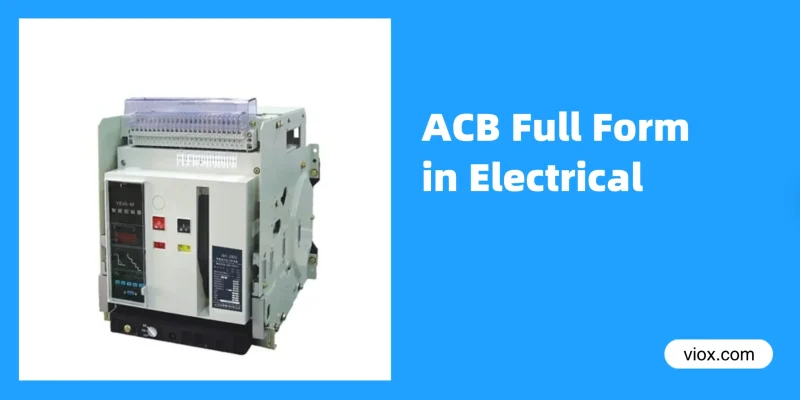Воздушный автоматический выключатель (ACB) - это важнейшее электрозащитное устройство, предназначенное для защиты низковольтных цепей от сверхтоков, вызванных перегрузками и короткими замыканиями, работающее при атмосферном давлении в воздухе.
Обзор воздушных автоматических выключателей
Воздушные автоматические выключатели (ACB) являются важнейшими компонентами электрических систем, предназначенными для защиты низковольтных цепей, работающих при напряжении 415 Вольт. Эти устройства функционируют как защитные механизмы от различных электрических неисправностей, включая сверхтоки, перегрузки и короткие замыкания. ACB работают в атмосферном воздухе, что отличает их от других типов автоматических выключателей, которые могут использовать различные среды для гашения дуги. Их основная задача - прерывать протекание тока при обнаружении аномальных условий, обеспечивая безопасность и целостность электрических систем в различных промышленных и коммерческих приложениях.
Объяснение механизма работы
При обнаружении неисправности устройство запускает последовательность действий, чтобы эффективно прервать прохождение тока. Сначала разъединяются главные контакты, передавая ток на дугогасящие контакты. Под действием электромагнитных сил дуга втягивается вверх в дугогасительный желоб, где охлаждается и гаснет. Этот процесс обеспечивает полное размыкание цепи, предотвращая повреждение электрических систем и повышая безопасность.
Общие области применения АКБ
Воздушные автоматические выключатели находят широкое применение в различных промышленных и коммерческих объектах, где надежная защита электричества имеет решающее значение. Они обычно используются в:
- Промышленные установки и электрические машины, обеспечивающие защиту высокомощного оборудования.
- Объекты с риском пожара или взрыва, где работа на воздухе обеспечивает дополнительный уровень безопасности.
- Вспомогательное оборудование электростанций, обеспечивающее защиту критически важных систем жизнеобеспечения.
- Применения на низких и высоких токах/напряжениях, демонстрирующие их универсальность в различных электрических требованиях.
- Внутреннее распределительное устройство среднего напряжения, служащее ключевым компонентом в системах распределения электроэнергии.
Эти применения подчеркивают важность ACB для обеспечения электробезопасности и эффективности работы в различных условиях.
Стандартные рейтинги АКБ
Воздушные автоматические выключатели обычно выпускаются в двух основных диапазонах номиналов для удовлетворения различных требований к электрическим системам. Стандартные номиналы включают:
- От 400A до 1600A для приложений с меньшей мощностью.
- От 2000A до 5000A для более высоких потребностей в мощности.
Эти номиналы позволяют гибко подбирать АКБ для конкретных электроустановок, обеспечивая оптимальную защиту и производительность в широком диапазоне промышленных и коммерческих условий.
ACB в сравнении с другими выключателями
Воздушные автоматические выключатели (ACB) отличаются от других автоматических выключателей по нескольким ключевым аспектам:
- Размер и текущая мощность: ACB больше и выдерживают более высокие номинальные токи (от 400A до 6300A) по сравнению с автоматическими выключателями в литом корпусе (MCCB), которые обычно варьируются от 10A до 800A.
- Функции защиты: ACB обеспечивают более комплексную защиту, включая защиту от длительной задержки, короткой задержки, мгновенную защиту, защиту от заземления, перенапряжения и обрыва фазы. Они также предоставляют возможности измерения и связи, в то время как MCCB в основном сосредоточены на защите от перегрузки и короткого замыкания.
- Закалка дуги: Для гашения дуги в АВР используется воздух под атмосферным давлением, что делает их более безопасными и простыми в обслуживании, чем масляные выключатели. Однако для высоковольтных систем электропередач предпочтительнее использовать вакуумные выключатели (ВКВ) благодаря их превосходным дугогасящим способностям и более высокой прочности изоляции.
- Применение: ACB обычно используются в крупных распределительных сетях, в то время как MCCB больше подходят для коммерческих и промышленных объектов с более низкими требованиями к току.
Эти различия делают ACB идеальными для конкретных применений, где требуется высокая токовая мощность и комплексная защита, в то время как другие типы автоматических выключателей могут быть более подходящими в различных сценариях в зависимости от напряжения, пространства и требований к защите.
Промышленные применения АКБ
Воздушные автоматические выключатели (ACB) играют важнейшую роль в промышленности, обеспечивая необходимую защиту и управление для различных мощных приложений. Вот некоторые типичные области применения АВР в промышленности:
- Распределение питания: ACB используются в главных распределительных щитах и центрах управления питанием для управления и защиты всей электрической системы на промышленных объектах.
- Защита машины: Они защищают критически важные электрические машины, такие как двигатели, трансформаторы и генераторы, от перегрузок и коротких замыканий.
- Промышленные заводы: ACB необходимы для управления электропитанием и защиты оборудования на крупных производственных и перерабатывающих предприятиях.
- Системы бесперебойного питания: Они интегрируются в системы бесперебойного питания для обеспечения надежного резервного питания и защиты чувствительного промышленного оборудования.
- Освещение и ОВКВ: ACB защищают системы освещения и оборудование для отопления, вентиляции и кондиционирования воздуха в промышленных зданиях.
- Мини-станции: Они используются в небольших энергетических установках в составе промышленных комплексов.
- Применение при высоких токах: АКБ особенно хорошо подходят для промышленных процессов, требующих высокой силы тока, от 400 до 6300 А.
Обеспечивая надежную защиту и управление в этих приложениях, ACB вносят значительный вклад в безопасность и эффективность промышленных электрических систем.


